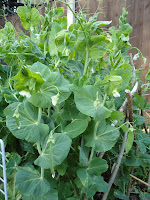Tuesday, 31 July 2012
Growing Peas for the First Time
This year has been a poor year for vegetable growing. The prolonged cold wet weather resulted in a very poor salad potato crop and the runner beans and dwarf beans have struggled to grow. Even the tomatoes in the greenhouse have been slow to grow and set fruit. Thankfully the weather has now warmed up, the sun has finally put in an appearance and the vegetable plants are growing strongly.
The one crop which has been a success despite the cold wet weather is the pea crop. This is the first time I have tried my hand at growing peas and I am pleased with the results. I planted 'Early Onward', a second early variety, in two rows about eighteen inches apart. The seeds were sown in v-shaped drills about 2-3 inches deep.
There were a lot of hard prunings from trees and shrubs at the bottom of the garden and some of these branches were used to support the peas. The branches were pushed into the soil at an angle creating a pleasing rustic effect, much nicer (and cheaper) than using the usual bamboo canes.
The pea seeds were sown directly into the ground in May. Usually second early varieties would be sown in April but due to the unusually cold weather it was mid May before they went into the ground. However, the pods are starting to fill out nicely now and I expect to be harvesting a decent crop over the next few weeks.
Wednesday, 25 July 2012
Attract Butterflies to Your Garden
There have been quite a few articles in the media this year detailing the decline in butterfly numbers. The adverse weather conditions we have experienced this year can only have made life more difficult for these beautiful insects, so perhaps it's time to think about planting with butterflies in mind.
Butterflies are a lovely sight in the garden, evocative of lazy summer days, plus they help to pollinate flowers for fruit and seed so it is in the gardener's interest to encourage them. Adult butterflies require nectar, so suitable nectar rich plants chosen for their flowering season will provide food from early spring to late autumn.
Good plants for attracting butterflies include Aubrieta, Arabis, Primroses, Sweet William and Wallflowers which are spring flowering; Phlox, Lavender, Buddleia, Red Valerian and Salvia which are summer flowering; Sedum spectabile, Asters, Helenium, Hebe and Verbena bonariensis which flower in autumn. Butterflies, like most insects, love warmth, shelter and sunshine so try and plant your nectar rich flowers in a sheltered suntrap.
Butterfly larvae need different food sources such as stinging nettles, thistles and grasses - not so popular with the average gardener. But if you can find a corner to let some of these grow without invading the rest of the garden it could be beneficial to the local butterfly population. Even better would be an area of wild flower meadow but most people just don't have the space to do this.
Two good books for anyone wanting to create a butterfly garden are 'Garden Plants for Butterflies' by Matthew Oates and 'The Butterfly Gardener' by M. Rothschild and C. Farrell.
Butterflies are a lovely sight in the garden, evocative of lazy summer days, plus they help to pollinate flowers for fruit and seed so it is in the gardener's interest to encourage them. Adult butterflies require nectar, so suitable nectar rich plants chosen for their flowering season will provide food from early spring to late autumn.
Good plants for attracting butterflies include Aubrieta, Arabis, Primroses, Sweet William and Wallflowers which are spring flowering; Phlox, Lavender, Buddleia, Red Valerian and Salvia which are summer flowering; Sedum spectabile, Asters, Helenium, Hebe and Verbena bonariensis which flower in autumn. Butterflies, like most insects, love warmth, shelter and sunshine so try and plant your nectar rich flowers in a sheltered suntrap.
Butterfly larvae need different food sources such as stinging nettles, thistles and grasses - not so popular with the average gardener. But if you can find a corner to let some of these grow without invading the rest of the garden it could be beneficial to the local butterfly population. Even better would be an area of wild flower meadow but most people just don't have the space to do this.
Two good books for anyone wanting to create a butterfly garden are 'Garden Plants for Butterflies' by Matthew Oates and 'The Butterfly Gardener' by M. Rothschild and C. Farrell.
Subscribe to:
Posts (Atom)


